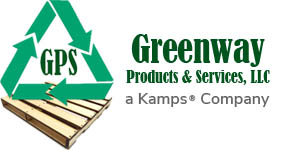Pallets Protect Freight to be Shipped
If you want your products to be delivered intact, with minimal time to load and unload, appropriately sized pallets will keep freight safe, and reduce the time, labor, and cost of loading and unloading. The optimal pallet size is determined by the size of the product being shipped, and trailer space available. Standard size pallets have been developed to maximize the amount of freight that can fit in truck trailers.
North American Standard Pallet Sizes
GMA Pallets
More than 30% of pallets used in the U.S. are sized to accommodate consumer packaged goods. These pallets conform to standard pallet sizes developed by the Grocery Manufacturers Association (GMA). Standard GMA sized pallet dimensions are 48″ x 40″, and can hold up to 4,600 lbs. This size pallets are often called GMA pallets. The GMA pallet’s typically weighs 37 lbs., and its height is 6 ½” tall. The deck boards measure 3 ½” wide 5/16” thick each.
Other Common Pallet Dimensions & Sizes
After GMA pallets, the most common pallet dimensions are 42” x 42” and 48” x 48” respectively.
Pallet Types
In addition to the pallet size, you will want to specify the pallet type. Your selection of pallet type and construction is determined by how you will be moving pallets, and the weight the pallet will need to support.
The wood sections on the sides of the pallets are called stringers. The least expensive pallet type is a stringer pallet. The stringer boards have cutout notches, where the forklift tines enter and then lift the pallet. Stringer pallets are either 2-way entry pallets, where the lift can load the pallet from only two of the four sides, or a partial 4-way entry. Partial 4-way pallets can be entered from all four sides with a forklift, but only from two sides with a pallet jack.
For freight that is moved by forklift, pallet jack, or conveyors, and for heavier loads, block pallets are recommended. Block pallets are more flexible when it comes to handling, as they can be lifted from any of the four sides — referred to as full 4-way entry pallets. Conveyor systems may also require block pallets have bottom deck boards that run in both directions.
In summary,
- Two-way, “unnotched” pallets
Forklift openings on only two sides, and smaller side openings on remaining sides.
Stringer boards are on the outside perimeter of the pallet only - Stringer pallets
Forklift openings on only two sides. Middle stringer boards are added in addition to the stringer boards on the perimeter of the pallet for extra support - Four-way pallets
Forklift openings on all four sides, providing the most flexible maneuverability for loading and unloading - Block Pallets
Forklift openings on all four sides, with extra support of solid wood blocks at the end of the stringer boards to support greater loads
The number of deck boards used on the top surface and pallet bottom also add to the strength and durability of the pallet.
Greenway Products & Services standard sturdy stringer pallet sizes are listed below, giving the pallet size, number of top deck boards, number of bottom deck boards, number of stringers, the resulting safe maximum load, and average pallet weight.

Top Deck Number: 7
Bottom Deck Number: 5
Stringers Number: 3
Safe Maxium Load: 4592 lbs.
(Stacked 1 Unit Load High)
Average Pallet Weight: 37 lbs.
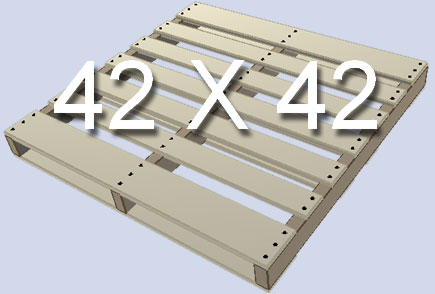
Bottom Deck Number: 4
Stringers Number: 3
Safe Maxium Load: 4445 lbs.
(Stacked 1 Unit Load High)
Average Pallet Weight: 36 lbs.
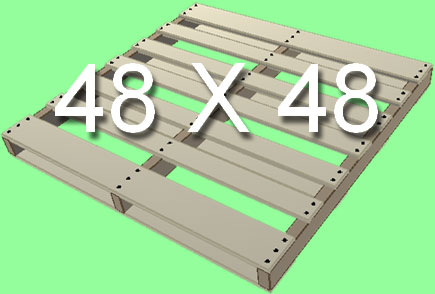
Bottom Deck Number: 3
Stringers Number: 3
Safe Maxium Load: 4673 lbs.
(Stacked 1 Unit Load High)
Average Pallet Weight: 37 lbs.
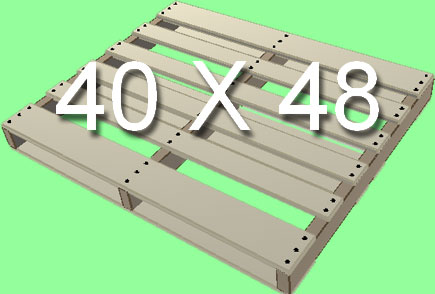
Bottom Deck Number: 4
Stringers Number: 3
(1 extra Stringer can hold 9.901 lbs.)
Safe Maxium Load: 3696 lbs.
(Stacked 1 Unit Load High)
Average Pallet Weight: 42 lbs.

Bottom Deck Number: 4
Stringers Number: 3
Safe Maxium Load: 4333 lbs.
(Stacked 1 Unit Load High)
Average Pallet Weight: 35 lbs.

Bottom Deck Number: 3
Stringers Number: 3
Safe Maxium Load: 3544 lbs.
(Stacked 1 Unit Load High)
Average Pallet Weight: 29 lbs.

Bottom Deck Number: 3
Stringers Number: 3
Safe Maxium Load: 3544 lbs.
(Stacked 1 Unit Load High)
Average Pallet Weight: 32 lbs.
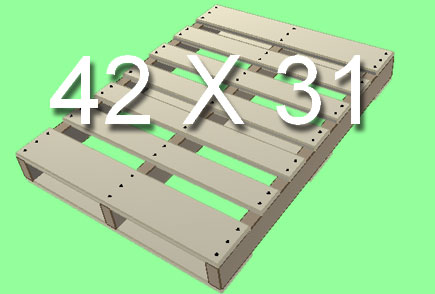
Bottom Deck Number: 3
Stringers Number: 3
Safe Maxium Load: 6585 lbs.
(Stacked 1 Unit Load High)
Average Pallet Weight: 33 lbs.
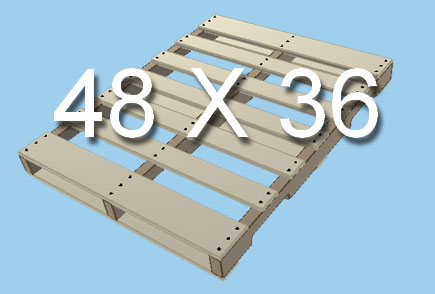
Bottom Deck Number: 3
Stringers Number: 3
Safe Maxium Load: 5261 lbs.
(Stacked 1 Unit Load High)
Average Pallet Weight: 31 lbs.
North American Pallet Sizes
| Inches (WxL) | mm (WxL) | Usage Rank | Safe Max. Load* | Industrial Use | Pallets per 48′ Dry Van** | Pallets per 53′ Dry Van** |
|---|---|---|---|---|---|---|
| 48 x 40 | 1219 x 1016 | 1 | Up to 4592 lbs. | Military, Cement | 480 | 520 |
| 42 x 42 | 1067 x 1067 | 2 | Up to 4445 lbs. | Telecommunications, Paint | 520 | 600 |
| 48 x 48 | 1219 x 1219 | 3 | Up to 4673 lbs. | Drums | 480 | 520 |
| 40 x 48 | 1016 x 1219 | 4 | Up to 4,600 lbs. | Dry goods, Dairy, Produce | 560 | 600 |
| 40 x 40 | 1016 x 1016 | 5 | Up to 3544 lbs. | Dairy | 560 | 600 |
| 48 x 42 | 1219 x 1067 | Up to 3696 lbs. | Chemical, Beverage | 500 | 540 | |
| 36 x 36 | 914 x 914 | Up to 3544 lbs. | Beverage | 640 | 680 | |
| 42 x 31 | 1067 x 787 | Up to 6585 lbs. | Tiles | 780 | 900 | |
| 48 x 36 | 1219 x 914 | Up to 5261 lbs. | Beverage, Shingles, Packaged Paper | 480 | 520 | |
| 44 x 44 | 1118 x 1118 | Up to 4,825 | Drums, Chemical | 520 | 560 |
* This is only an estimate based on 5/8 hardwood boards, 1 ½ stringers, floor loaded only, and 2 inch nails. Strength may vary depending on nails use, broken components, and times used. Please contact us to get a precise estimate.
** Confirm truck load quantities with your carrier
Common Interntional Pallet Sizes
| Inches (WxL) | mm (WxL) | Wasted floor ISO Container |
Continent |
|---|---|---|---|
| 48 x 40 | 1219 x 1016 | 3.7% | North America |
| 47.24 x 39.37 | 1200 x 1000 | 6.7% | Europe, Asia; similar to 48×40” |
| 44.88 x 44.88 | 1140 x 1140 | 8.1% | Australia |
| 42 x 42 | 1067 x 1067 | 11.5% | North America, Europe, Asia |
| 43.30 x 43.30 | 1100 x 1100 | 14% | Asia |
| 31.50 × 47.24 | 800 × 1200 | 15.2% | Europe; fits many doorways |
Four Common European Pallet Sizes
And ISO Alternative Sizes
The European EURO pallets, also referred to as CEN pallets, are used in many Europe. EURO pallet manufacturers must be conform to the European Pallet Association (EPAL) strict standards. The strict standardization is based on the existence of europool pallet swap organizations – their mutual swap agreements across country boundaries does only include EURO pallets of a specific EPAL/EUR type (mostly restricted to type 1). EURO pallets do not fit efficiently within the ISO shipping container, and require slightly wider containers.
| Inches (WxL) | mm (WxL) | EURO Pallet Type | ISO Pallet Alternative |
|---|---|---|---|
| 31.50 × 47.24 | 800 × 1200 | EUR, EUR 1 | ISO1, same size as EUR |
| 47.24 × 39.37 | 1200 x 1000 | EUR 2 | ISO2 |
| 39.37 × 47.24 | 1000 × 1200 | EUR 3 | |
| 31.50 × 23.62 | 800 × 600 | EUR 6 | |
| 43.30 x 43.30 | 1100 x 1100 | ISO0, half the size of EUR | |
| 23.62 × 15.75 | 600 × 400 | quarter the size of EUR | |
| 15.75 × 11.81 | 400 × 300 | one-eighth the size of EUR |

